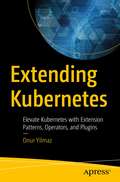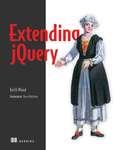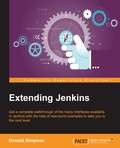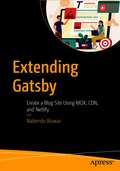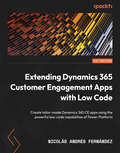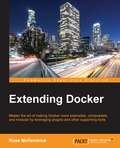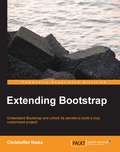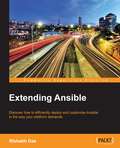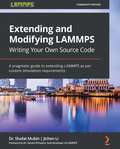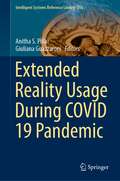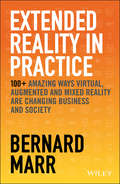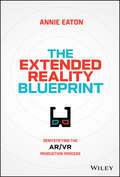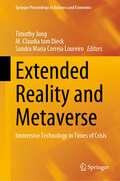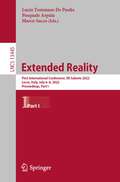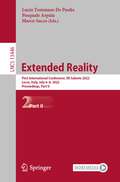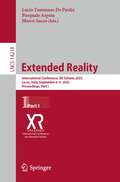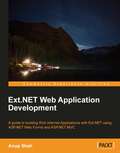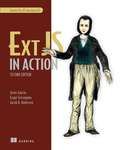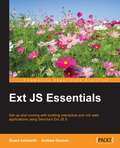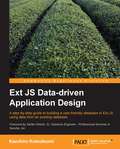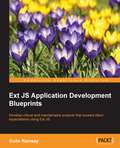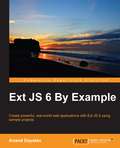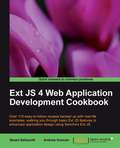- Table View
- List View
Extending Kubernetes: Elevate Kubernetes with Extension Patterns, Operators, and Plugins
by Onur YilmazRely on this comprehensive guide to understand the extension patterns and discover the extension plugins for Kubernetes.In this book, state-of-the-art extension patterns and extension points of Kubernetes are covered in depth with real-life use cases and examples. There are comprehensive discussions in the text on all possible aspects of Kubernetes, starting from end-user to the fully-automated controller development. The book focuses on creating applications that work on Kubernetes and also interact and operate Kubernetes itself.The book starts with a recap of Kubernetes, its rich configuration options, extension patterns, and points. The journey of extending Kubernetes starts with the CLI tool plugins. By the end of this section, you will be able to create and manage kubectl plugins. Then, the API access plugins with authentication and authorization webhooks are presented. In this section, you will learn how to extend and interfere with the API flow of Kubernetes. You then move on to learn how to extend Kubernetes API with new resources and controllers. You will make Kubernetes API work for you by creating a Kubernetes operator. Extensions for Kubernetes schedulers are covered to create a custom scheduler and run it side-by-side with the default scheduler. Finally, the last extension points will be discussed for the infrastructure, such as networking or storage. At the end of the text, you will learn the upcoming extension points. This book is designed to cover all the extension points of Kubernetes with state-of-the-art implementations. This book is intended for those who wish to understand Kubernetes in depth and go further by making Kubernetes work for their custom requirements. By the end of this book, readers with a cloud-native mindset will broaden their vision to create future-proof applications. Rather than focus on overwhelming theoretical information and YAML files for Kubernetes resources, readers are provided with the philosophy behind Kubernetes extensions. With real-life examples and hands-on development steps, you will be more confident in working with Kubernetes.What You Will LearnKnow the Kubernetes extension patterns and available extension points Be familiar with the philosophy behind Kubernetes extensions and how they should be integrated into the clustersDesign Kubernetes extensions and make Kubernetes work for youDevelop, deploy, and operate plugins for Kubernetes ranging from the CLI tool to custom resources, schedulers, infrastructure, and more Study real-life use cases for extending Kubernetes with code examplesWho This Book Is ForSoftware engineers, developers, DevOps engineers, cloud security analysts, architects, and managers who have Kubernetes in their short- and long-term plans
Extending jQuery
by Keith WoodSummaryExtending jQuery teaches you to build custom extensions to the jQuery library. It covers all the extension points within jQuery and provides guidelines and techniques on how to make use of them. You'll not only discover how to write plugins, but how to design them for maximum reuse. You'll also learn how to write new widgets and effects for jQuery UI. Along the way, you'll explore extensions in key areas including Ajax, events, animation, and validation.About the TechnologyjQuery, the most popular JavaScript library, helps make client-side scripting of HTML easy. It offers many built-in abilities to traverse and alter the DOM, but it can't do everything. Fortunately, you can tap into jQuery's numerous extension points to create your own selectors and filters, plugins, animations, and more.About this BookExtending jQuery teaches you to build custom extensions to the jQuery library. In it, you'll discover how to write plugins and how to design them for maximum reuse. You'll also learn to write new widgets and effects for the jQuery UI. Along the way, you'll explore extensions in key areas including Ajax, events, animation, and validation.This book assumes intermediate-level knowledge of jQuery and JavaScript. No experience writing plugins or other extensions is required.Purchase of the print book includes a free eBook in PDF, Kindle, and ePub formats from Manning Publications.What's InsideCreate jQuery UI widgets and effectsMake extensions available for distribution and reuseBuild your own librariesAbout the AuthorKeith Wood has developed over 20 jQuery plugins including the original Datepicker, World Calendar, Countdown, and SVG.Table of ContentsPART 1 SIMPLE EXTENSIONSjQuery extensionsA first pluginSelectors and filtersPART 2 PLUGINS AND FUNCTIONSPlugin principlesCollection pluginsFunction pluginsTest, package, and document your pluginPART 3 EXTENDING JQUERY UIjQuery UI widgetsjQuery UI mouse interactionsjQuery UI effectsPART 4 OTHER EXTENSIONSAnimating propertiesExtending AjaxExtending eventsCreating validation rules
Extending Jenkins
by Donald SimpsonGet a complete walkthrough of the many interfaces available in Jenkins with the help of real-world examples to take you to the next level with Jenkins About This Book * Find out how to interact with Jenkins from within Eclipse, NetBeans, and IntelliJ IDEA * Develop custom solutions that act upon Jenkins information in real time * A step-by-step, practical guide to help you learn about extension points in existing plugins and how to build your own plugin Who This Book Is For This book is aimed primarily at developers and administrators who are interested in taking their interaction and usage of Jenkins to the next level. The book assumes you have a working knowledge of Jenkins and programming in general, and an interest in learning about the different approaches to customizing and extending Jenkins so it fits your requirements and your environment perfectly. What You Will Learn * Retrieve and act upon Jenkins information in real time * Find out how to interact with Jenkins through a variety of IDEs * Develop your own Form and Input validation and customization * Explore how Extension points work, and develop your own Jenkins plugin * See how to use the Jenkins API and command-line interface * Get to know how to remotely update your Jenkins configuration * Design and develop your own Information Radiator * Discover how Jenkins customization can help improve quality and reduce costs In Detail Jenkins CI is the leading open source continuous integration server. It is written in Java and has a wealth of plugins to support the building and testing of virtually any project. Jenkins supports multiple Software Configuration Management tools such as Git, Subversion, and Mercurial. This book explores and explains the many extension points and customizations that Jenkins offers its users, and teaches you how to develop your own Jenkins extensions and plugins. First, you will learn how to adapt Jenkins and leverage its abilities to empower DevOps, Continuous Integration, Continuous Deployment, and Agile projects. Next, you will find out how to reduce the cost of modern software development, increase the quality of deliveries, and thereby reduce the time to market. We will also teach you how to create your own custom plugins using Extension points. Finally, we will show you how to combine everything you learned over the course of the book into one real-world scenario. Style and approach Extending Jenkins explores and explains advanced Jenkins functionality from a practical point of view, teaching you real-world skills that will help you get more from this powerful software. Each key topic is explained clearly with a practical example, and in sufficient detail so you understand the concepts and can then develop your own solutions using your preferred software and languages.
Extending Gatsby: Create a Blog Site Using MDX, CDN, and Netlify
by Nabendu BiswasExpand your Gatsby development skills by building a production-ready blog website. This book teaches you how to use Gatsby alongside the latest technologies including MDX, CDN, and Netlify. In this project, you will create a very complex and large blog site with just MDX files and learn to optimize images using CDN for faster website loading. You will also learn to continuously deploy to Netlify enabling you to provide daily site updates easily. To get the most out of this book you should be comfortable with the basics of React and familiar with Gatsby fundamentals as covered in Foundation Gatsby Projects, which provides several stepping stone projects. Rather than cover how to create a simple blog site, Extending Gatsby goes beyond the basics to extend your blogging skills. What You'll Learn Develop a production-ready, complex, blogging system site with MDXLearn to make a complete mobile siteContinuously deploy your site using NetlifyAdd functionalities with the powerful Gatsby plugin ecosystem Who This Book Is For This book is for developers who are familiar with Gatsby and are looking to create an extended blog site. Knowledge of React is expected. You will also need to be familiar with JavaScript concepts and be confident with basic web development.
Extending Dynamics 365 Customer Engagement Apps with Low Code: Create tailor-made Dynamics 365 CE apps using the powerful low-code capabilities of Power Platform
by Nicolas Andres FernandezCustomize your Dynamics 365 customer engagement apps to increase business productivity and customer value at scale using a low-code approachKey FeaturesLeverage Power Apps and customize Dynamics 365 CE apps to implement advanced business case scenariosCreate automation with Power Automate to empower Dynamics 365 CE users to increase their productivityEasily build bots using Power Virtual Agents for both internal and external use casesBook DescriptionExtending Dynamics 365 Customer Engagement Apps with Low Code helps you gain a comprehensive, practical understanding of how a no-code/low-code project approach works for Dynamics 365 (D365) Customer Engagement (CE). This book covers the most relevant native capabilities for configuration, along with real-world scenarios to showcase the magic of extending D365 CE apps with Power Platform. The book starts by identifying different scenarios and use cases to extend D365 CE apps with a low-code approach. You'll learn about the different capabilities of Dataverse and Power Apps used to extend native applications. Next, you'll discover how to leverage Power Apps, both Canvas apps and model-driven apps, and Power Pages, to build apps and portals around D365 CE processes. You'll also explore Power Automate's capabilities to create or modify business processes, as well as incorporate new processes and automation. As you advance, you'll also discover how Power Virtual Agents can be implemented in D365 CE apps. The book concludes by teaching you to integrate Power BI natively with customer engagement, thus facilitating the construction of advanced reports and dashboards. By the end of this book, you'll have gained hands-on expertise in customizing CE apps with Power Platform to deliver more scalable and maintainable solutions.What you will learnLeverage the capabilities of Dataverse and Power Apps to extend Dynamics 365 CE native applicationsCreate Canvas and model-driven apps on top of Dynamics 365 CE applicationsIntegrate AI Builder capabilities with Dynamics 365 CE for advanced solutionsCreate automation with business process flow, cloud flows, and classic workflowsDeploy a chatbot and integrate it with Dynamics 365 CE processesEmbed Power BI dashboards and reports in Dynamics 365 CE appsWho this book is forThis book is for Dynamics 365 developers, solutions architects, technical functional consultants, and pre-sales architects working on Dynamics 365 customer engagement who want to customize and extend their customer engagement apps with the power of low-code/no-code technology, and gain practical experience in using Power Platform components to deliver scalable, maintainable, and intelligent solutions to their clients. Working knowledge of Dynamics 365 and basic knowledge of low-code/no-code technology will help you get the most out of this book.
Extending Docker
by Russ MckendrickMaster the art of making Docker more extensible, composable, and modular by leveraging plugins and other supporting tools About This Book * Get the first book on the market that shows you how to extend the capabilities of Docker using plugins and third-party tools * Master the skills of creating various plugins and integrating great tools in order to enhance the functionalities of Docker * A practical and learning guide that ensures your investment in Docker becomes more valuable Who This Book Is For This book is for developers and sys admins who are well versed Docker and have knowledge on basic programming languages. If you can't wait to extend Docker and customize it to meet your requirements, this is the book for you! What You Will Learn * Find out about Docker plugins and the problems they solve * Gain insights into creating your own plugin * Use Docker tools to extend the basic functionality of the core Docker engine * Get to grips with the installation and configuration of third-party tools available to use with Docker plugins * Install, configure, and use a scheduling service to manage the containers in your environment * Enhance your day-to-day Docker usage through security, troubleshooting, and best practices In Detail With Docker, it is possible to get a lot of apps running on the same old servers, making it very easy to package and ship programs. The ability to extend Docker using plugins and load third-party plugins is incredible, and organizations can massively benefit from it. In this book, you will read about what first and third party tools are available to extend the functionality of your existing Docker installation and how to approach your next Docker infrastructure deployment. We will show you how to work with Docker plugins, install it, and cover its lifecycle. We also cover network and volume plugins, and you will find out how to build your own plugin. You'll discover how to integrate it with Puppet, Ansible, Jenkins, Flocker, Rancher, Packer, and more with third-party plugins. Then, you'll see how to use Schedulers such as Kubernetes and Amazon ECS. Finally, we'll delve into security, troubleshooting, and best practices when extending Docker. By the end of this book, you will learn how to extend Docker and customize it based on your business requirements with the help of various tools and plugins. Style and approach An easy to follow guide with plenty of hands-on practical examples which can be executed both on your local machine or externally hosted services.
Extending Bootstrap
by Christoffer NiskaPractical and instruction-based, this concise book will take you from understanding what Bootstrap is, to creating your own Bootstrap theme in no time! If you are an intermediate front-end developer or designer who wants to learn the secrets of Bootstrap, this book is perfect for you.
Extending Ansible
by Rishabh DasDiscover how to efficiently deploy and customize Ansible in the way your platform demands About This Book * Get the first book on the market that maximizes the functionalities of Ansible * Master the skill of extending Ansible by deep diving into its modules and plugins * Work through this step-by-step guide to customizing Ansible according to your requirements Who This Book Is For This book is perfect for developers and administrators who are familiar with Ansible and Python programming, but have no knowledge of how to customize Ansible. What You Will Learn * Get a thorough understanding of Ansible modules * Find out everything about plugins that fit in the Ansible architecture * Get to grips with designing modules and handling errors * Work with data structures * Distribute Ansible extensions using PyPi and Git submodules * Get to know the various distribution methods of modules and plugins In Detail Ansible is an IT automation tool that lets you manage your Infrastructure as a Code. It helps you deploy your applications and manage configurations, thus making life easier. Ansible, in most ways, is self sufficient to address most of your requirements. Ideally, standard modules, libraries, or plugins are used to automate a given IT platform. Customizing Ansible can be done by custom module and plugin development. This book shows you how to automate most of the tasks in your IT environment, thus minimizing the need to manually perform scheduled tasks and extend your Ansible implementation by developing customized modules and plugins. You'll begin by getting an understanding of the fundamental aspects of extending the Ansible framework, such as custom functions and reusable modules. You'll then progress to building custom plugins and extensions using the fundamental building blocks explained earlier. We'll also show you how to automate some tasks using scripts. Finally, we'll demonstrate how these extensions can be seamlessly integrated into existing Ansible installations and explain how to conduct unit testing on these extensions to ensure they work as desired. Style and approach This book is a learning book on the fundamentals of Ansible framework and how it can be leveraged to extend it using the modules and plugins.
Extending and Modifying LAMMPS Writing Your Own Source Code: A pragmatic guide to extending LAMMPS as per custom simulation requirements
by Dr. Shafat Mubin Jichen Li Dr. Steven PlimptonUnderstand the LAMMPS source code and modify it to meet your research needs, and run simulations for bespoke applications involving forces, thermostats, pair potentials and more with easeKey FeaturesUnderstand the structure of the LAMMPS source codeImplement custom features in the LAMMPS source code to meet your research needsRun example simulations involving forces, thermostats, and pair potentials based on implemented featuresBook DescriptionLAMMPS is one of the most widely used tools for running simulations for research in molecular dynamics. While the tool itself is fairly easy to use, more often than not you'll need to customize it to meet your specific simulation requirements. Extending and Modifying LAMMPS bridges this learning gap and helps you achieve this by writing custom code to add new features to LAMMPS source code. Written by ardent supporters of LAMMPS, this practical guide will enable you to extend the capabilities of LAMMPS with the help of step-by-step explanations of essential concepts, practical examples, and self-assessment questions. This LAMMPS book provides a hands-on approach to implementing associated methodologies that will get you up and running and productive in no time. You'll begin with a short introduction to the internal mechanisms of LAMMPS, and gradually transition to an overview of the source code along with a tutorial on modifying it. As you advance, you'll understand the structure, syntax, and organization of LAMMPS source code, and be able to write your own source code extensions to LAMMPS that implement features beyond the ones available in standard downloadable versions. By the end of this book, you'll have learned how to add your own extensions and modifications to the LAMMPS source code that can implement features that suit your simulation requirements.What you will learnIdentify how LAMMPS input script commands are parsed within the source codeUnderstand the architecture of the source codeRelate source code elements to simulated quantitiesLearn how stored quantities are accessed within the source codeExplore the mechanisms controlling pair styles, computes, and fixesModify the source code to implement custom features in LAMMPSWho this book is forThis book is for students, faculty members, and researchers who are currently using LAMMPS or considering switching to LAMMPS, have a basic knowledge of how to use LAMMPS, and are looking to extend LAMMPS source code for research purposes. This book is not a tutorial on using LAMMPS or writing LAMMPS scripts, and it is assumed that the reader is comfortable with the basic LAMMPS syntax. The book is geared toward users with little to no experience in source code editing. Familiarity with C++ programming is helpful but not necessary.
Extended Reality Usage During COVID 19 Pandemic (Intelligent Systems Reference Library #216)
by Anitha S. Pillai Giuliana GuazzaroniThis book explores the benefits to online teaching incorporating extended reality technologies both from a teacher’s and from a students’ perspective. As we are all aware, the COVID-19 pandemic has created a worldwide lock down which is clearly visible in individuals’ shifting behaviour as they are keeping away from public contact, large events, weddings, places of worship, public transportation, restaurant, flights, shopping malls, etc. People across the world have adopted to Work From Home (WFH) concept using digital technology. They are teaching, learning, conducting meetings, seminars, etc., using digital medium. As people were not allowed to go out and buy things, online shopping was in demand and extensible reality helped in marketing the products and customers could also have a better shopping experience. Gaming industry has always brought in many new games for children and adults. Healthcare sector also leveraged the benefits of this technology to the fullest extent. The use of augmented and virtual reality in art and museum is also highlighted. Our book presents the different sectors that have benefitted using this technology during this time of crisis. This book will be very useful for students, professionals and researchers working in the area of virtual, augmented or mixed reality. Our aim is to bring out the use of this technology during the COVID-19 pandemic so that the readers are exposed to the various applications of this technology.
Extended Reality in Wirtschaft, Wissenschaft, Gesellschaft und Medien: Immersive Technologien und virtuelle Welten: Grundlagen, Status quo, Ein- und Ausblicke
by Bolela Likafu Christian MaltererDieses Buch gibt einen grundlegenden und holistischen Überblick über die Extended-Reality-Branche (XR) in Deutschland. XR beschreibt als Sammelbegriff Augmented Reality, Virtual Reality und Mixed Reality – also virtuelle Welten, in denen sich derzeit nicht nur im Gaming-Bereich vollkommen neue Interaktionspotentiale und Geschäftsmodelle eröffnen. Solche immersiven Technologien werden in Zukunft für nahezu alle Lebens- und Wirtschaftsbereiche interessant sein: Marketing, Medizin, Handel, Forschung, Bildung oder Kultur – um nur einige zu nennen.Dieses Werk ist aus einer Initiative der Herausgeber entstanden, innerhalb der deutschen Immersive-Media-Branche einen offenen XR-Thinktank als dynamische Austauschgemeinschaft heterogener Akteure und Stakeholder ins Leben zu rufen.Ziel des Buches ist es, das Thema einzuordnen und seine Relevanz anhand von Fallstudien aus verschiedenen Branchen sowie Experteninterviews zu untermauern. Die Beitragsautoren und Interviewpartner wollen so den Wissenstransfer vorantreiben.
Extended Reality in Practice: 100+ Amazing Ways Virtual, Augmented and Mixed Reality Are Changing Business and Society
by Bernard MarrDiscover one of the biggest business trends of today Extended reality (XR for short) – which encompasses virtual reality, augmented reality and mixed reality – is one of the biggest business trends of today. It refers to the use of technology to create more immersive digital experiences which are promising to transform many businesses and industries. In this book, best-selling author, strategic business advisor, and respected futurist Bernard Marr explains the role of XR in providing innovative businesses solutions for companies of varying sizes and across different industries. He introduces the three main branches of extended reality - virtual, augmented and mixed reality. You will discover how businesses and organisations are implementing the technology, with case examples, including some of the world’s biggest brands, to showcase how they are starting to use XR in practice. Extended Reality in Practice is a must read for anyone wanting to learn exciting and entirely new ways for people to experience the world around them – and for businesses, new ways to connect and engage with customers and improve business processes.
The Extended Reality Blueprint: Demystifying the AR/VR Production Process
by Annie EatonFollow a tried-and-tested approach to integrating augmented and virtual reality into your business The Extended Reality Blueprint focuses on design for non-gaming or gaming adjacent applications in extended reality (XR), including augmented and virtual reality. Author Annie Eaton is a leading producer of immersive content in the XR space. Many of Annie's clients come to her with the same questions, often not knowing where to begin as they seek to implement extended reality solutions into their business. This book presents the discovery and product development process through an immersive technology lens. You will walk through the XR production process and learn how to apply this technology directly within your organizations in a meaningful and effective way. Join leading businesses like Delta Air Lines, Mars Wrigley, Georgia-Pacific, and JLG Industries, and learn how top companies are leveraging XR for greater market share, engagement, and profit. Learn about the latest applications of extended reality (XR), including augmented and virtual reality. Discover the steps of the XR product development process, including how to find profitable uses of XR and decide on technology suites. Assemble effective teams of XR developers, designers, artists, and other key members to bring your projects to fruition and success. Learn from the real-world examples and lessons learned of businesses that have taken the leap into extended reality. The Extended Reality Blueprint, delivers a concrete, actionable process for brining extended reality into your organization and embracing this crucial technology to remain current.
Extended Reality and Metaverse: Immersive Technology in Times of Crisis (Springer Proceedings in Business and Economics)
by Timothy Jung M. Claudia tom Dieck Sandra Maria Correia LoureiroThis book features the latest research in the area of immersive technologies as presented at the 7th International Extended Reality (XR) Conference, held in Lisbon, Portugal in 2022.Bridging the gap between academia and industry, it showcases the latest advances in augmented reality (AR), virtual reality (VR), extended reality (XR) and metaverse and their applications in various sectors such as business, marketing, retail, education, healthcare, tourism, events, fashion, entertainment, and gaming. The volume gathers selected research papers by prominent AR, VR, XR and metaverse scholars from around the world. Presenting the most significant topics and latest findings in the fields of augmented reality, virtual reality, extended reality and metaverse, it will be a valuable asset for academics and practitioners alike.
Extended Reality: First International Conference, XR Salento 2022, Lecce, Italy, July 6–8, 2022, Proceedings, Part I (Lecture Notes in Computer Science #13445)
by Lucio Tommaso De Paolis Pasquale Arpaia Marco SaccoThis two volume proceedings, LNCS 13445 and 13446, constitutes the refereed proceedings of the 9th International Conference on Augmented Reality, Virtual Reality, and Computer Graphics, XR Salento 2022, held in Lecce, Italy, July 6–8, 2022. Due to COVID-19 pandemic the conference was held as a hybrid conference.The 42 full and 16 short papers were carefully reviewed and selected from 84 submissions. The papers discuss key issues, approaches, ideas, open problems, innovative applications and trends in virtual reality, augmented reality, mixed reality, applications in cultural heritage, in medicine, in education, and in industry.
Extended Reality: First International Conference, XR Salento 2022, Lecce, Italy, July 6–8, 2022, Proceedings, Part II (Lecture Notes in Computer Science #13446)
by Lucio Tommaso De Paolis Pasquale Arpaia Marco SaccoThis two volume proceedings, LNCS 13445 and 13446, constitutes the refereed proceedings of the 9th International Conference on Augmented Reality, Virtual Reality, and Computer Graphics, XR Salento 2022, held in Lecce, Italy, July 6–8, 2022. Due to COVID-19 pandemic the conference was held as a hybrid conference.The 42 full and 16 short papers were carefully reviewed and selected from 84 submissions. The papers discuss key issues, approaches, ideas, open problems, innovative applications and trends in virtual reality, augmented reality, mixed reality, applications in cultural heritage, in medicine, in education, and in industry.
Extended Reality: International Conference, XR Salento 2023, Lecce, Italy, September 6-9, 2023, Proceedings, Part II (Lecture Notes in Computer Science #14219)
by Lucio Tommaso De Paolis Pasquale Arpaia Marco SaccoThis two-volume set LNCS 14218 and LNCS 14219 constitutes the refereed proceedings of the International Conference on Extended Reality, XR Salento 2023, held in Lecce, Italy, during September 6-9, 2023. The 59 full papers presented together with 11 short papers were carefully reviewed and selected from 97 submissions. They cover a wide range of many different research topics such as: eXtended reality; digital twin; artificial intelligence; user experience in eXtended reality; virtual reality for neurofeedback, biofeedback and emotion recognition; eXtended reality in education; eXtended reality and metaverse in cultural heritage; eXtended reality in health and medicine; and eXtended reality in industrial field.
Extended Reality: International Conference, XR Salento 2023, Lecce, Italy, September 6-9, 2023, Proceedings, Part I (Lecture Notes in Computer Science #14218)
by Lucio Tommaso De Paolis Pasquale Arpaia Marco SaccoThis two-volume set LNCS 14218 and LNCS 14219 constitutes the refereed proceedings of the International Conference on Extended Reality, XR Salento 2023, held in Lecce, Italy, during September 6-9, 2023. The 60 full papers presented together with 11 short papers were carefully reviewed and selected from 97 submissions. They cover a wide range of many different research topics such as: eXtended reality; digital twin; artificial intelligence; user experience in eXtended reality; virtual reality for neurofeedback, biofeedback and emotion recognition; eXtended reality in education; eXtended reality and metaverse in cultural heritage; eXtended reality in health and medicine; and eXtended reality in industrial field.
Ext.Net Web Application Development
by Anup ShahThis is a step-by-step tutorial packed with examples and tips to learn Ext.NET from scratch. This book is written for .NET Web Application Developers who are familiar with ASP.NET looking to build .NET based Rich Internet Applications. Whether you are new to Ext JS or you are looking to use your existing Ext JS skills in a .NET environment, this book will be useful for you.
Ext JS in Action
by Grgur Grisogono Jacob Andresen Jesus GarciaSummaryExt JS in Action, Second Edition teaches Ext JS from the ground up. You'll start with a quick overview of the framework and then explore the core components by diving into complete examples, engaging illustrations, and crisp, straightforward explanations. You'll feel like you have an expert guide right at your elbow teaching you important Ext techniques and offering insight into its inner workings. Along the way, you'll learn the best practices for building and scaling full-featured web applications, including how to customize and build Ext widgets. Fully revised for Ext JS 4.0.About this BookExt JS is a mature JavaScript web application framework that provides modern UI widgets and an advanced MVC architecture. It helps you manage tedious boilerplate and minimize hand-coded HTML and browser incompatibilities.Ext JS in Action, Second Edition starts with a quick overview of the framework and then explores the core components by diving into complete examples, engaging illustrations, and clear explanations. You'll feel like you have an expert guide at your elbow as you learn the best practices for building and scaling full-featured web applications.A working knowledge of JavaScript is assumed. No prior experience with Ext JS is required.Purchase of the print book includes a free eBook in PDF, Kindle, and ePub formats from Manning Publications.What's InsideBuilding professional web apps with Ext JSStamping out DOM fragments with templatesCustomizing and building Ext widgetsMasterful UI designFully revised for Ext JS version 4.0About the AuthorsJay Garcia is a well-known member of the Ext JS community and a contributor to the framework. He wrote Sencha Touch in Action. Grgur Grisogono founded SourceDevCon in London, UK and Split, Croatia. Jacob Andresen is a consultant specializing in large scale internet applications.Table of ContentsPART 1 INTRODUCTION TO EXT JS 4.0A framework apartDOM manipulationComponents and containersPART 2 EXT JS COMPONENTSCore UI componentsExploring layouts Forms in Ext JSThe data storeThe grid panelTaking root with treesDrawing and chartingRemote method invocation with Ext DirectDrag-and-dropPART 3 BUILDING AN APPLICATIONClass system foundationsBuilding an application
Ext JS Essentials
by Stuart Ashworth Andrew DuncanIf you are a developer looking to develop rich Internet applications, then this book is for you. This book assumes that you have experience developing software and enables you to quickly hit the ground running with this amazing framework.
Ext JS Data-driven Application Design
by Kazuhiro KotsutsumiAn in-depth tutorial that teaches you the basics of data-driven applications, and how to design and implement them using Ext JS.If you are an intermediate in Sencha Ext JS, "Ext JS Data-Driven Application Design" is the tutorial for you. You need to be familiar with JavaScript and have basic operational knowledge of MySQL. If you want to be able to systematically construct an application from the first step to implementation, this book will be useful for you.
Ext JS Application Development Blueprints
by Colin RamsayIf you are a developer who has knowledge of Ext JS but would like to expand it to encompass the bigger picture of application development, then this book is ideal for you.
Ext JS 6 By Example
by Anand DayalanCreate powerful, real-world web applications with Ext JS 6 using sample projects About This Book * Explore, debug, and get practical by extending the sample projects, including a sample RESTful API project in Ext JS 6 * Gain a quick and easy understanding through working source code and get an explanation of multiple cool sample projects * A project-based guide to help you get your hands on real-world applications Who This Book Is For If you're a front web developer who is looking to learn a new JavaScript framework, or if you already know about Ext JS and are looking for a practical resource with multiple example projects to get expert-level knowledge in Ext JS, then this guide will be a great resource for you. A basic understanding of HTML, CSS, and JavaScript is expected. What You Will Learn * Install Ext JS Sencha Cmd 6 and debugging tools such as Illumination, App Inspector, and Sencha Fiddle * Understand and apply the core concepts and querying capabilities of Ext JS 6 * Dive deep into powerful components such as Grid, Data View, Trees, and different kinds of charts including 3D charts as well as Bar, Area, Pie, Line charts * Discover how an Ext JS 6 application communicates with the server side through Data Packages such as Stores and Proxies * Discover how to create responsive web applications and client-side routing * Acquire and implement knowledge on accessibility, localization, and the drag-and-drop and theming capabilities of Ext JS 6 In Detail Ext JS is one of the most famous JavaScript frameworks used to create rich interactive web applications using techniques such as Ajax, DHTML, JSON, and DOM scripting. It provides a complete rich set of GUI controls, has an excellent API for AJAX and REST, and helps users to organize their code with Model View ViewModel (MVVM) or the MVC architecture, and supports two-way data binding, responsive layouts, responsive design, and more. It is an extensive, one-stop-shop to build an JavaScript RIA application. This book starts with a clear step-by-step installation guide for Ext JS 6 and the additional tools required for development on both Mac and Windows operating systems. It then covers the core concepts and fundamentals of Ext JS 6. We move on to focus on multiple basic GUI controls such as buttons, message boxes, and menus, and a sample project that covers the fundamental and basic GUI controls. You'll also learn how to design a form with form fields such as a text field, number field, date picker, label, and radio button, and learn about form validation. We proceed to show you how to organize your code using the MVVM application architecture, and you'll then jump into advanced controls such as Grids, Trees, Data Views, and Charts. You'll also learn about the API required for AJAX and REST communication, and learn all need to know about Ext JS Data Packages. A working RESTful API sample project is included to help you explore the Data Packages. Finally, we end with a discussion on responsive design, theming your application, and the available plugins. Style and approach This is an example-based guide to help you develop rich Internet applications using Ext JS 6. Most of the chapters start with a particular concept and code example, and end with a cool sample project that uses the concepts learned in the chapter.
Ext JS 4 Web Application Development Cookbook
by Andrew Duncan Stuart AshworthThis is a cookbook with easy to follow recipes containing practical and detailed examples which are all fully backed up with code, illustrations, and tips. The Ext JS 4 Web Application Development Cookbook is aimed at both newcomers and those experienced with Ext JS who want to expand their knowledge and learn how to create interactive web applications with Ext JS 4.
